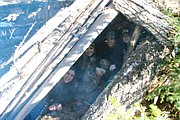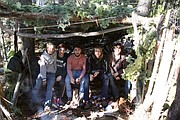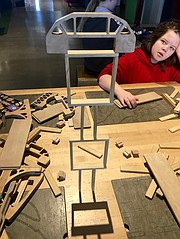Getting outside the bubble
MULLAN — As Mullan Jr./Sr. High School principal Don Kotschevar puts it, we in the Silver Valley tend to live in our own little world — especially the City of Mullan.
And though many of us enjoy this smaller and less fast-paced way of living, it still can never hurt to see what else the world has to offer.
For the students of MHS, they have the opportunity to learn outside the walls of the school and gain new experiences with “Adventures in Education” day.
Organized by Kotschevar, the monthly ‘class’ allows students with different interests to see what the world (or at least, our region) has to offer.
The most recent Adventures in Education Day on Nov. 20 had students breaking into two groups — one that was more interested in science and art, and another that preferred to be more hands-on.
The hands-on group, composed of 25 students of all ages, were led by Kotschevar into the Mullan wilderness that Tuesday morning to learn a little bit about survival.
“We live in a dangerous world and at any time you could end up outside the norm,” Kotschevar explained. “It’s a good idea to know what it would take to survive.”
The 25 students broke into groups and were tasked with building a shelter that could take a beating and then create a source of heat.
“We went up in the woods in a nice spot and built shelters that had to be good enough to protect us from wind and rain,” freshman Luke Trogden said, “then after that we had to build a fire.”
Each group went up with roughly the same type of gear, such as rope and fire starter, but most the of shelters had to be made with what they could find in nature.
After three hours, the groups then had to test their shelters by jumping on them.
Although there is still some disagreement over which group had the best shelter, Trogden still had fun and learned some practical skills that could come in handy (especially where we live).
“It’s nice to get out of the school building and go do stuff.”
The other group of 17 students, who were more interested in science and art, were treated with a field trip to the Mobius Science Center in Spokane, Wash., that same morning.
This is the third year in a row that MHS students have visited the popular learning exhibit to see what new theme they have.
Sophomore Emily Dykes explained that many of the exhibits this year were centered around physics and currency, but there were also many other activities that hit on other fields of science.
“This one had a lot of physics involved. Lots of flying planes and electricity,” she said. “Then they had a money one, like specifically ‘why did we use these types of money’ and how does money work.”
For two hours, the Mullan students bounced from activity to activity and took in all the Center had to offer.
From building castles out of cardboard to making their own dollar bills — there was certainly a lot to do.
“The physics and stuff is really fun to just kind of look into and see how it all works,” Dykes said. “Everything there is hands-on.”
Speaking of hands-on, one of Dykes’ favorite parts of the trip was working with the topography activity.
“There was this sand box, but it had a projector on it, so when you pushed sand up it would show the change in elevation,” she explained. “It was a topography thing and I’ve seen them around at college exhibitions, but that was really fun to work with because when you dug down to a certain spot, it would turn into water. You could make it rain with your hands. It was really cool.”
For Dykes, the most beneficial part of going to Mobius is that it allowed her and her fellow students the opportunity to “look into the science and see how they can actually apply their thinking to a physical thing.”
Last year’s exhibit focused on human anatomy and included an actual body showing nerves and muscles.
Whether it be the survival group or the Mobius group, Kotschevar believes that these non-traditional classes and lessons are needed for the small town students.
“We live in a very small area, and for us to get outside of our area, we have to travel and see other things,” he explained. “Our kids are sheltered, so we try to get them outside this bubble we live in here because they may want to live somewhere else, and unless they get outside of the bubble, they’ll never know what’s out there.”
Kotschevar tailors these Adventures in Education to force the kids out of their comfort zones and gain some new perspectives by meeting new people and seeing new things.
“Mullan is just a speck on the map,” he said, “there’s a whole world out there.”







